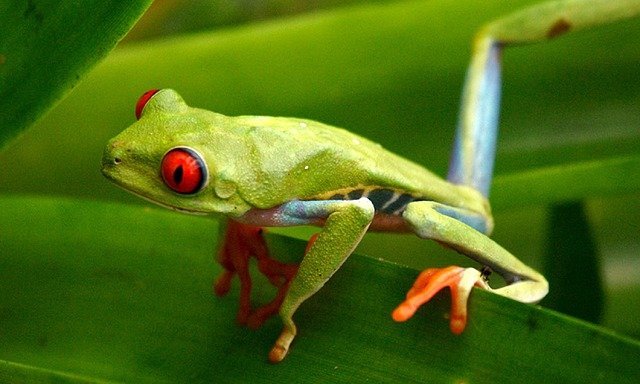When we think of red-eyed tree frogs, we generally think of adorable little Kermit the Frog types that are harmless and sweet. The truth is, they are fairly ferocious in their own right and are quite quirky little buggers. They have some interesting habits that will have you taking a double-take.
Did you know that red-eyed tree frogs have:
- Been around for millions of years
- Vibrate wildly to mark their territory
- Stun predators with a flash of color
- They taste awful
- Fierce mating habits
- Fast-hatching eggs
#1 Millions Of Years and Millions More
Researchers have found fossils proving that red-eyed tree frogs were climbing trees around 10 million years ago. For the most part, ancient frogs have evolved into something else or vanished from the face of the earth. However, or rugged little friend has not changed in millions of years.
#2 Good Vibrations
Male frogs will climb their way onto a branch and grip it and rip it. This means that red-eyed tree frogs hang onto the branch and fiercely vibrate to ward off other males. Vibrations have been clocked to travel about 1.5 meters for a good perimeter of space. Usually, males are more territorial when its mating season. The vibrations are to let other male frogs know that this spot is their bachelor pad and to move on.
#3 Color Power
For the most part, red-eyed tree frogs work at camouflaging themselves in trees. That’s hard to do with magnificently red eyes and the blue and yellow bursts of color on their sides, or so you would think. These clever frogs use the colors to their advantage.
When he is perched, he tucks his bold-colored legs into himself, concealing the colors. If our little buddy senses a predator, he will close his eyes and when the predator gets near, he stuns them by opening his red eyes and exposing his colorful sides, making the predator hesitate because the appearance of color is so abrupt.
The frog is able to scurry off while the predator shakes off the confusion. By the time the predator realizes what he saw, the red-eyed tree frog has escaped and concealed himself in a new location.
#4 Awful Taste
You may be wondering, who would eat a frog? Well, over 100 million frog legs are shipped each year internationally. The good news is that red-eyed tree frogs are not a delicacy, they taste quite horrid. Red-eyed tree frogs have toxic skin. It’s not really lethal, but it would make you ill. Some species won’t eat the frogs because of the residual bad taste.
#5 Fierce Mating Habits
Red-eyed tree frog mating is much like the main event rodeo. What better way to attract a mate then sit and scream for her? Male frogs will nestle into a desirable location around water and call out to the females.
The female frog will pick her mate, the vetting process is not known but probably relates to how loud the call is and the male’s size. The female will travel over to his location and allow her mate to hop on her back. She carries him back to her bad or one of an ideal location above water; that part is important.
When she finds her leaf above the water, she crawls to the underbelly of the leaf with her male companion clinging to her and uses the water on the leaf to lay her eggs, which are a jelly-like ooze. The male fertilizes the eggs externally from her back.
Now, in the midst of this chaos, other males are hopping on her back as well, trying to wrestle her chosen mate off her back. So, in fertilizing the eggs, it could be more than one froggy, daddy. If that isn’t enough, after the female lays her eggs and they are fertilized, she lets go and spirals into the water below, taking the male frog (or frogs) with her.
If the male can hang on for another ride up the tree while other males are trying to dogpile the couple, he will successfully fertilize another batch of eggs. Brutal.
#6 Fast Hatching Eggs
We last saw our eggs on the bottom of a leaf after being fertilized. The tadpoles from these eggs hatch in about four or five days but can hatch sooner and that’s where it gets interesting. When the eggs hatch, the tadpoles fall into the water, before that happens, the eggs on the leaf are a delicacy for predators.
If predators come around, the tadpoles can hatch early as a defense mechanism. This will allow them to pop out and fall into the water evading the predator. This is probably one of the many reasons they have been around for millions of years, the babies know when to scoot and are able to survive.
Final Thoughts
Red-eyed tree frogs are fairly remarkable in their survival skills. They are interesting little creatures and sure to last the test of time.




